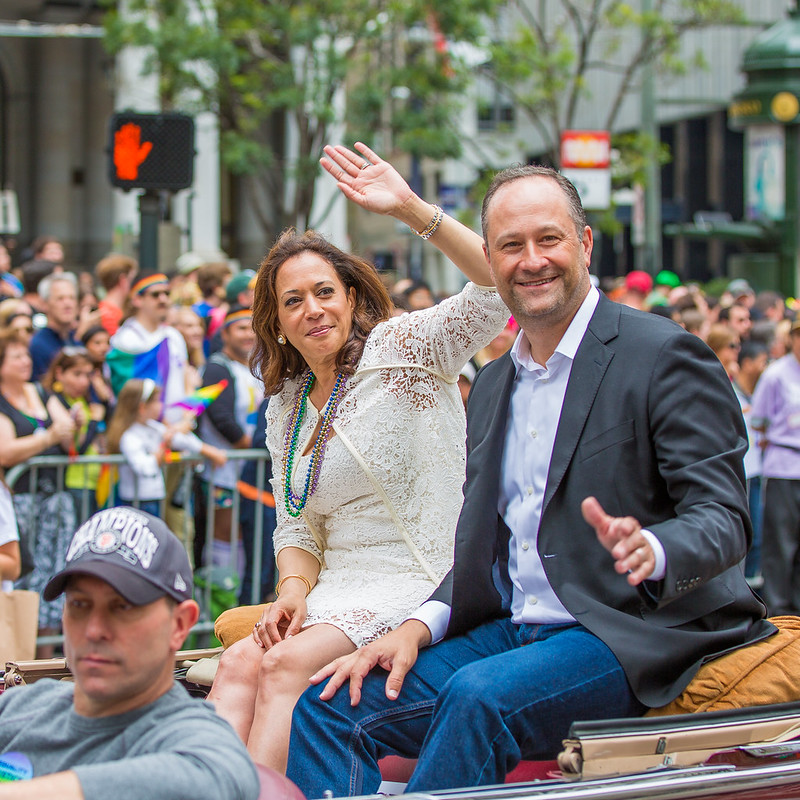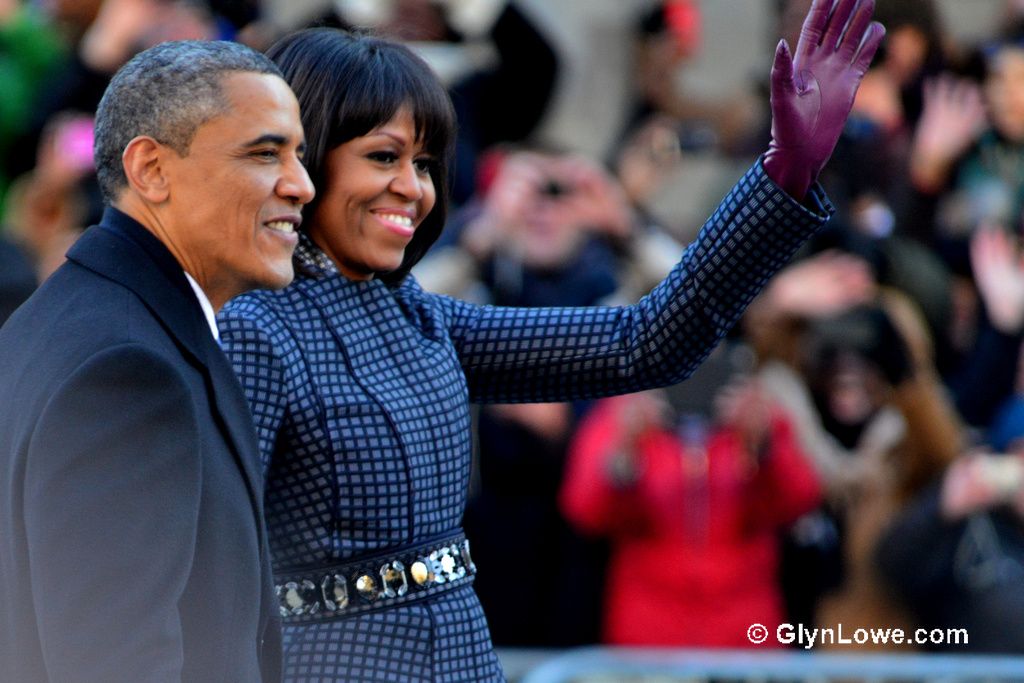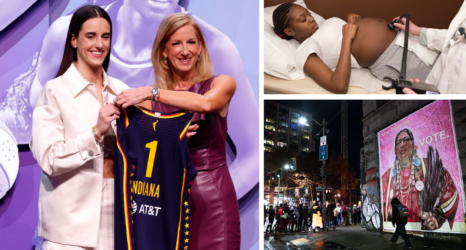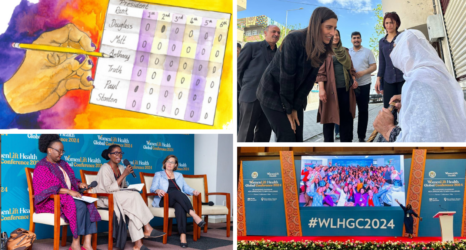
It should go without saying that an interracial marriage does not negate one’s Blackness. In recent weeks, however, that’s exactly the question popping up on Black social media sites since Kamala Harris became the Democratic nominee for vice president of the United States: Is she Black enough because her husband is white?
A self-professed Black woman of Jamaican and South Asian parentage, Harris married Brooklyn-born entertainment attorney Douglas Emhoff in 2014. And now beyond Harris’s criminal and social justice records, her Blackness has come into question more than a few times.
It echoes conversations during Obama’s 2008 presidential bid, in which Black women—on social and IRL—were quick to point out that Barack would not have even been a contender in their minds had Michelle been white. Even if she’d been lighter complexioned, many owned up that they would have dismissed him. Outright.
It’s an old yarn spun anew—and one with which we must grapple as a community if we are to move beyond outdated ideas of what it means to Black.
We’re not talking about some Rachel Dolezal-style co-opting of another culture when your own no longer works for you. This is about understanding how deep and fluid Blackness flows through the very soul of this nation; a radical acceptance for the array of experiences in which Blackness can show up, activate and become a force for real change in our communities.
What we make of this moment is on us.
Blackness, however, has nothing to do with skin color or parentage, but culture; it’s heritage and a state of mind that we share, and it’s a disservice to Black consciousness to belittle our own because of their spouse.
Our notion of what constitutes “white” and what constitutes “Black” is a product of social context, writes Ta-Nehasi Coates in his 2013 essay, “What We Mean When We Say Race is a ‘Social Construct'”:
“It is utterly impossible to look at the delineation of a ‘Southern race’ and not see the Civil War, the creation of an ‘Irish race’ and not think of Cromwell’s ethnic cleansing, the creation of a ‘Jewish race’ and not see anti-Semitism. There is no fixed sense of ‘whiteness’ or ‘blackness,’ not even today. It is quite common for whites to point out that Barack Obama isn’t really ‘black’ but ‘half-white.’ One wonders if they would say this if Barack Obama were a notorious drug-lord.”
Coates continues:
“When the liberal says ‘race is a social construct,’ he is not being a soft-headed dolt; he is speaking an historical truth. We do not go around testing the ‘Irish race’ for intelligence or the ‘Southern race’ for ‘hot-headedness.’ These reasons are social. It is no more legitimate to ask ‘Is the black race dumber than then white race?’ than it is to ask ‘Is the Jewish race thriftier than the Arab race?‘
“The strongest argument for ‘race’ is that people who trace their ancestry back to Europe, and people who trace most of their ancestry back to sub-Saharan Africa, and people who trace most of their ancestry back to Asia, and people who trace their ancestry back to the early Americas, lived isolated from each other for long periods and have evolved different physical traits (curly hair, lighter skin, etc.)
“But this theoretical definition (already fuzzy) wilts under human agency, in a real world where Kevin Garnett, Harold Ford and Halle Berry all check ‘Black‘ on the census. (Same deal for “Hispanic.”) The reasons for that take us right back to fact of race as a social construct. And an American-centered social construct. Are the Ainu of Japan a race? Should we delineate darker South Asians from lighter South Asians on the basis of race? Did the Japanese who invaded China consider the Chinese the same ‘race‘”?
For our part, we both identify as Black women. Janice is a Gen-X Californian born to two African American parents. Haley is a Texas Gen-Zer of mixed-parentage: half-white and half-Black.
But in an America still held hostage by the vestiges of slavery, and the “one drop rule,” we are both seen as 100 percent Black—despite the diverse ancestry that comprises Haley’s DNA and experiences. We are more than a generation apart, and yet the politicizing of Blackness remains a mainstay in our lives.
At the heart of the matter in the case of interracial couplings is a sense of racial or community loyalty. Historically, high-profile Black Americans who partnered with non-Black (specifically white) partners were seen as somehow above or outside of the community.
Pulitzer Prize-winning author Isabel Wilkerson explores America’s hierarchy of human divisions in her recently-released book Caste: The Origins of Our Discontents. She writes:
“As a means of assigning value to entire swaths of humankind, caste guides each of us beyond the reaches of our awareness. It embeds into our bones an unconscious ranking of human characteristics and sets forth the rules, expectations, and stereotypes that has been used to justify brutalities against entire groups within our species. In the American caste system, the signal of rank is what we call race, the division of humans on the basis of their appearance. In America, race is the primary tool and the visible decoy, the front man, for caste. …
“It is the historic flash card to the public of how they are to be treated, where they are expected to live, what kinds of positions they are expected to hold, whether they belong in this section of town or that seat in the boardroom, whether they should be expected to speak with authority on this or that subject, whether they will be administered pain relief in a hospital, whether their neighborhood is likely to adjoin a toxic waste site or to have contaminated water flowing from their taps, whether they are more or less likely to survive childbirth in the most advanced nation in the world, whether they may be shot by authorities with impunity.”
While the election of President Barack Obama appeared to have flipped the script on that hierarchy—those eight years when America deemed itself “post-racial”—so much of Obama’s personal decisions, including his choice to marry, were determined by race, according to historian David Garrow’s 2017 biography Rising Star: The Making of Barack Obama.
In the book, Garrow reveals Obama’s marriage proposal to a former girlfriend Sheila Miyoshi Jager in the fall of 1986. She said “not yet”; her mother thought Obama, two years Jager’s junior, was too young.
As discussions of marriage continued, Obama’s ambitions changed and “it was affected by what Sheila describes as Barack’s ‘torment over this central issue of his life’, the question of his own ‘race and identity,’” Garrow writes. The “resolution of his ‘Black’ identity was directly linked to his decision to pursue a political career’ and to the crystallization of the ‘drive and desire to become the most powerful person in the world.'”

The Guardian says the book strongly implies that his preference for Michelle, an African American, over Jager, who is half-Dutch and half-Japanese, was politically motivated.
“Barack’s prior relationships had been with women who, like himself through 1985, were citizens of the world as much as they were of any particular country or city,” Garrow writes. “But if Barack truly believed that his destiny entailed what he thought, he knew full well the value of having roots in one place and having that place be essential to your journey. And who more than Michelle Robinson and her family could personify the strong, deep roots of black Chicago?”
As the Black Lives Matter movement surges, so too has the swell of pan-Africanism, an ideology that champions “collective self-reliance” among peoples of the Diaspora—principles Malcolm X championed in his later years. It’s an idea his eldest daughter Ambassador Attallah Shabazz says has become convoluted by race.
“Pan-Africanism was not about hues or tones,” Shabbazz said during a forum at USC in Los Angeles earlier this year, “it was about independence for those of the African diaspora, and those of the African diaspora could be those of blood or of influence. We redefined pan-Africanism here.
“Here you have people who say, ‘Is Tiger Woods Black enough,’ or ‘Is Mariah Carey Black enough?’ That’s not what pan-Africanism is. That’s not even what Black Pride is. So ‘pan’ means all those who are in the realm of or descendants of or extensions of … and that can go all the way to the South Pacific Seas, it can be throughout Europe. It can be in South America. Pan-African is going to come with the blend of people who are multi-combinations. If you want to politicize it, you’ve now changed its intention.”
Even now, Black American media outlets can on one hand sing praises on the marriage of Megan Markle to Prince Harry, shout out the accomplishments of Jordan Peele and Serena Williams (both married to non-Black spouses)—while on the other, post memes featuring Donald Glover and his non-Black partners question whether he can be an activist for the community. (But as Childish Gambino, he’s seen as a Black avenger.)
In his Forward to Rebecca Walker’s Black Cool: One Thousand Streams of Blackness, Henry Louis Gates, Jr. wrote,
“On the one hand, blacks as a group share culture, language, and experience that join us inextricably together, but as individuals, we may well act in our own self- interest, without regard to the needs of ‘the community.’”
Black love is worthy of celebration, and is famously heralded today from the pages of Essence to docustories on OWN. But if we are to embrace the assertion of ‘love is love is love,’ then snatching ‘Black’ cards from folks just because they’ve chosen a partner outside the race fundamentally confuses things when we also profess to be ‘rooting for everybody Black.’
As one of the fastest growing demographics in the country, mixed Americans are broadening the discourse on race, identity, and the American experience. Harris’s intersectionality—as a woman of mixed race and culture, in a mixed-raced, blended marriage—signals something important to us today: That Black people are a growing part of a larger community; interconnected to broader cultures, religions and ideas that will shape this country for generations to come.
There is so much more we can learn from one another if we allow ourselves to be open to it. In the polarized socio-political climate in which we live, Harris is a dynamic embodiment of what can happen when people come together.
When love wins, everyone wins.
You may also like:





